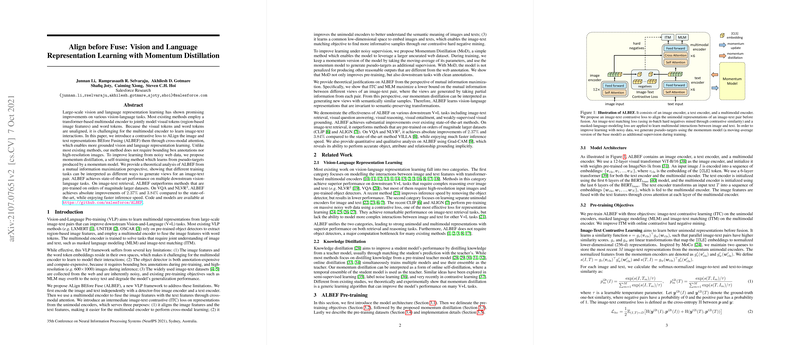Align before Fuse: Vision and Language Representation Learning with Momentum Distillation
The paper introduces a novel vision-language pre-training (VLP) framework named "Align before Fuse" (ALBEF), which aims to address several limitations inherent in traditional VLP approaches. The key innovation of ALBEF lies in introducing a contrastive loss to align image and text representations before fusing them using cross-modal attention, and employing momentum distillation for improved representation learning under noisy data conditions.
Key Contributions
ALBEF Framework
The ALBEF model consists of an image encoder based on ViT-B/16, a text encoder initialized with the first six layers of BERT_base, and a multimodal encoder using the last six layers of BERT_base. The primary objective is to align unimodal representations before applying a multimodal encoder, thus facilitating a more grounded representation learning process.
Intermediate Image-Text Contrastive Loss
ALBEF introduces an intermediate image-text contrastive (ITC) loss on the unimodal encoders. This loss performs three key functions:
- Aligns visual and textual features, facilitating subsequent cross-modal learning.
- Enhances the understanding of image and text semantics independently.
- Forms a common low-dimensional space for embedding images and texts, aiding the image-text matching objective through contrastive hard negative mining.
Momentum Distillation
To handle noisy supervision from web data, the authors propose momentum distillation (MoD). This method leverages pseudo-targets generated by a momentum model, which is an exponential moving average of the base model's parameters. This approach allows the model to be less penalizing toward other reasonable yet different outputs, enhancing its generalization capabilities.
Theoretical Underpinning
The paper provides a mutual information maximization perspective, demonstrating that the ITC and MLM losses in ALBEF maximize a lower bound on the mutual information between different views of an image-text pair. This theoretical grounding extends to interpreting momentum distillation as generating new, semantically similar views, thus enforcing invariance to semantic-preserving transformations.
Numerical Results
ALBEF showcases substantial numerical improvements across multiple vision-language benchmarks:
- On image-text retrieval tasks, ALBEF outperforms methods pre-trained on significantly larger datasets (like CLIP and ALIGN).
- It achieves absolute improvements of 2.37% in Visual Question Answering (VQA) and 3.84% in Natural Language Visual Reasoning (NLVR2) compared to the state-of-the-art VILLA.
- ALBEF also exhibits faster inference speeds due to its enhanced architecture.
Implications and Future Directions
The practical implications of this research are extensive. By not requiring bounding box annotations or high-resolution images, ALBEF simplifies the pre-training process while simultaneously achieving superior performance. This methodological advancement opens avenues for more efficient and scalable VLP models that can leverage vast yet noisy datasets available on the web.
The utilization of momentum distillation for generating pseudo-targets suggests potential advancements in self-supervised learning frameworks. Future research could explore further refinements to the MoD approach or extend its application to other domains within multi-modal learning frameworks.
Conclusion
The ALBEF framework represents a significant step forward in vision-language representation learning by introducing an effective alignment mechanism before fusion and leveraging momentum distillation to handle noisy annotations. This results in superior and more efficient models, providing a solid foundation for future explorations and enhancements in multi-modal representation learning.
The proposed methods, validated through strong numerical results, could inspire future developments in the domain, particularly in addressing the scalability and efficiency challenges posed by large-scale, noisy pre-training data.
